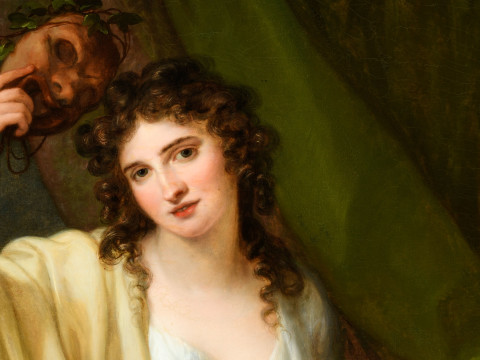
Start here: Angelica Kauffman
Published on 24 January 2024
Meet Angelica Kauffman, founding member of the Royal Academy and one of the most celebrated artists of her day.

The most cultivated woman in Europe
Angelica Kauffman was one of the most celebrated artists of the eighteenth century.
She painted the celebrities of her day: actors, writers, aristocrats, monarchs and socialites; she was a founding member of the Royal Academy of Arts; and she reinvigorated the genre of history painting – one of the prevailing artistic subjects of the period.
This exhibition follows her remarkable career from child prodigy to, in the words of the German philosopher Johann Gottfried Herder, “the most cultivated woman in Europe”.

Rising star
Kauffman was born in Switzerland. As a woman, she could not formally enrol at an art academy, so she was trained by her father who was also an artist. Following the death of her mother, Kauffman travelled around Europe with her father. They increasingly spent time in Italy, where she honed her craft by studying classical sculptures and the works of the Old Masters.
At the start of her career, she painted portraits of the high-ranking young British men on their ‘Grand Tour’ of Europe, as well as the scholars and artists she met in Italy.
Her portrait of the German art historian Johann Joachim Winckelmann was widely praised, and her portrait of the famous English actor and playwright David Garrick burnished her reputation as a painter of celebrities in Rome and overseas in London.
Encouraged by her popularity among British patrons in Italy, in 1766 Kauffman moved to London.

Royal Academician
Following her arrival in London, Kauffman was accepted into the inner circles of the art world. She secured commissions from Queen Charlotte and other royal women, and she quickly befriended one of the leading artists of the day, Joshua Reynolds.
In 1768, Angelica Kauffman was one of only two women artists among the 36 Founding Members of the Royal Academy. The other was Mary Moser, known for her intricate flower paintings.
As women, Kauffman and Moser didn’t have the same status as their male co-founders. They couldn’t attend committee meetings and dinners, and they weren’t allowed to work from life-models. Despite these barriers, Kauffman cemented her reputation at the Royal Academy’s prestigious annual exhibitions.

History painter
“History paintings” show narrative scenes from classical mythology, the Bible, or history. The founders of the Royal Academy considered this genre of painting to be the pinnacle of fine art.
Kauffman made ambitious history paintings throughout her career. She focused increasingly on female protagonists such as Cleopatra mourning Mark Antony or Christ meeting the Samaritan woman at the well.
When she was 23 Kauffman painted Penelope waiting wistfully at her loom for her husband Odysseus to return from the Trojan War. Penelope was not a character who was frequently depicted in history paintings at the time, but Kauffman based many compositions around her story and other artists followed.

At the height of her powers
In 1780, after twelve years of success exhibiting at the Royal Academy’s annual exhibitions, Kauffman’s four ceiling paintings depicting the ‘Elements of Art’ were unveiled in the Academy’s new rooms at Somerset House.
The works represent the key stages of creating an artwork: Invention, Design, Composition and Colouring. Breaking with convention, Kauffman represented all four disciplines as women. In Design the woman artist copies a cast of a classical torso, perhaps a defiant nod to the fact that women were forbidden to draw the body from life.
They were well received: with one critic stating that Kauffman had “exerted her very utmost powers”.

Celebrity in Rome
The year after the ‘Elements of Art’ were unveiled, Kauffman left London and eventually settled in Rome. She was at the heart of the cultural life of the city, working for international patrons and continuing to send paintings to the Royal Academy’s exhibitions.
In Rome she painted pioneering pictures of herself and fellow female friends and creatives. Blurring the boundaries between history painting and portraiture, she often represented her sitters as the muses of classical mythology.
When Kauffman died in 1807, a grand funeral was arranged in Rome. Friends, artists and leading cultural figures processed to the church. Shortly after, a bust of the artist was placed in the Pantheon, beside that of Raphael.

Book tickets for Angelica Kauffman
Follow Angelica Kauffman from child prodigy to one of Europe's most sought-after painters in our major exhibition.
Related articles

Start here: Brazilian Modernism
22 January 2025

A love letter to the gallery gift shop
18 November 2024

Start here: Florence c. 1504
27 September 2024

Start here: Michael Craig-Martin
9 August 2024

Start here: Modernism in Ukraine
28 May 2024
